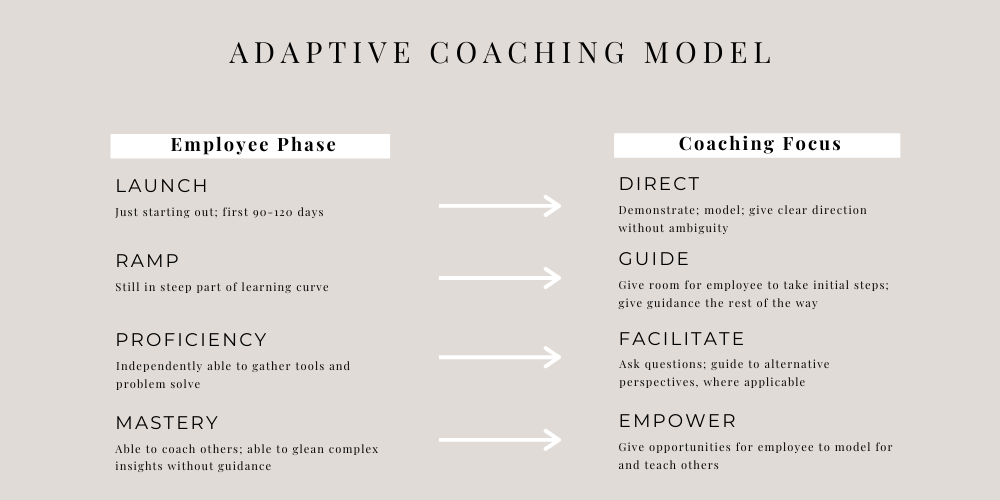The Adaptive Coaching Model
Have you ever known a leader who always seemed to intuit what each member of their team needed, exactly when they needed it? They’d ask different things of different employees, but rather than seeming unfairly preferential, did you notice this leader actually seemed to bring out the best in everyone?
If so, I bet he or she (knowingly or not) was using the Adaptive Coaching Model.
At its most basic level, adaptive coaching is a model for people managers to identify their employees’ level of mastery of a given task or skill, and then coach them accordingly.

Adaptive coaching is powerful because it’s the opposite of a one-size-fits-all approach to people management; it’s bespoke, tailored to each individual’s needs.
While this model can be helpful to all people managers and employees, I find it particularly helpful in three situations:
- In work settings where feedback tends to weigh more heavily toward negatives / areas of opportunity
- To help employees stay continuously engaged throughout their tenure
- To help people managers scale / avoid burnout / avoid micromanaging
Familiar Phases
Even if you hadn’t previously heard of the Adaptive Coaching Model, chances are, you’ve incorporated parts of it into your working relationship with your team members. Specifically, I find that managers adapt most easily to employees who are in launch or mastery phases because these are the most unambiguous circumstances in which to coach others.
However, it’s the in-between phases — ramp and proficiency — that require a much more nuanced approach. These are the phases that are often ignored or skipped over, yet are likely the most important for employee engagement and unlocking top performance.
How The Model is Used
To make the model even more practical, I’ve put together example actions for each coaching focus below.

A manager coaching an employee who’s in launch phase should direct them. That means demonstrating for them; modeling for them; giving clear direction without ambiguity. Using specific examples, that could mean telling the employee what data to pull; how to pull it; what to do with the data once it’s extracted; etc.
A manager coaching an employee who’s in ramp phase should guide them. That means giving room for the employee to take initial steps, then giving guidance the rest of the way. Using specific examples, that could mean asking what tools the employee is planning to use, what data they’re planning to pull and what framework they’re planning to use, and then telling them what to do with the data once they’ve pulled it.
A manager coaching an employee who’s in proficiency phase should facilitate them. That means asking questions and giving alternative perspectives. Practically, that could mean checking in with the employee after he or she has pulled data and gleaned insights from the data, and probing for alternative perspectives, new ideas, new ways of pulling the data, and new efficiencies for next time.
Finally a manager coaching an employee who’s in mastery phase should empower them. That means giving the employee opportunities to model for and teach others. While the employee could and should still run data analyses, he or she could also teach others how to do so at the same time.
Final Thoughts
While the Adaptive Coaching Model is a powerful tool, it can be misused. My references here are for leaders intending to unlock the highest and best potential from each employee.
My biggest recommendation on how to utilize this model successfully? Be transparent with your employees, especially in the in-between phases. The model (and your employees) will reward you for it.
Need more 1:1 guidance? Click here to schedule some time with me — I’d love to chat.
